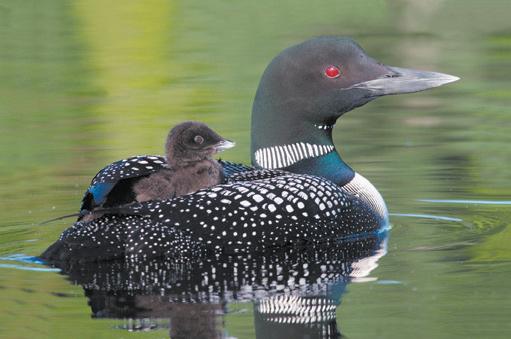
4 minute read
Outer Banks Wildlife: The Great Northern Diver
It’s this chilly time of year when the Outer Banks Wildlife Shelter admits more Loons than any other time. On their migratory journey south during late fall and winter, beautiful Common Loons, also called “Great Northern Divers,” one of the oldest and most primitive birds known, fly singly or in groups that have been clocked at more than 70 miles per hour, from Canada and the Northeastern United States in search of warmer waters along the Atlantic or the Gulf Coast.
When one is transported to our shelter at 100 Wildlife Way in Newport, it’s usually because someone found it beached or on the ground. The staff and volunteers at the shelter know when a Loon comes in, that it’s likely a very bad—possibly lethal—situation. We pray for a fishing gear injury. We consider that a blessing in a Loon’s case. Untangling line, removing hooks and treating wounds we can do something about.
Advertisement
It’s also not too bad if a migrating Common Loon accidentally lands, softly on a wet highway or parking lot, mistaking it for a river or lake. A loon may also get stranded on a small pond. In those situations, the Loon doesn’t have enough open water for the long take-off they need. A running start over as much as 400 yards and paddling furiously through the water is what they require to take flight. Their legs are placed far back on their bodies which are very good for swimming but does not enable them to walk on land, only awkward scooting by thrusting its chest forward a few inches and dragging both legs underneath their body. So, most people think they’ve come upon an injured bird when they see the Loon can’t stand or move about on land.
The worst diagnosis and unfortunately the most common, is mercury or lead poisoning. Loons born in the Northeast are exposed to large quantities of methylmercury, the form of mercury toxic to living things. These birds are particularly vulnerable to environmental poisoning for many reasons. They are longlived, up to 30 years and spend their lives in the water and because they are carnivores will feed mostly on fish, crustaceans, frogs and aquatic insects. Loons are divers that dive up to 250 feet. A typical foraging dive lasts about 40 seconds.
Loons mate for life. When common loons get to their breeding area and mate, the females lay their eggs beside bodies of water or in shallow water. The nest is usually built by both parents on the ground and the female typically lays two eggs each year. The female will then sit on the eggs for 27 to 30 days before they hatch and the parents share hatchling duties.
During the first week, chicks may crawl onto the back of a parent paddling along on the water’s surface. Chicks stay very close to their parents for the first three weeks and will respond immediately to calls warning
The Great Northern Diver
of raptorial birds (or airplanes) flying overhead by scrambling under an adult’s wing. The chicks grow very rapidly and are nearly the size of the adults within 4 to 6 weeks. They also begin to demonstrate their independence by seeking their own food, diving and exercising their wing muscles. The youngsters retain their dull grey back plumage during that time, although the belly turns white. At 2 to 3 years of age the young adults will be mature enough to mate. Loons have a very distinct call and some people describe it as eerie or an unearthly tremolo cry, but for wildlife rehabilitators, we hear a beautiful song that awakens a sense of wilderness. Rather than a cry or wail, it’s more like a melancholy yodel. You always know when a loon is present at our shelter, they sing even in captivity, unlike other animals that tend to go silent in the unnatural environment of close human presence and in a building or kennel cab. Although difficult to describe, it’s impossible to forget their sound. Depending upon the reason they are being treated, their song can sound happy or sad, but that’s a subjective human assessment based on knowing their odds medically, otherwise, most people would consider a Loon’s song a soothing melody.
In cases of toxic poisoning, the best we can do is make them comfortable with frequent tub baths and extra padding to lessen chest compression when kenneled, give the Loons time to build up their strength with healthy fish feedings and monitor their weight. We also flush them with fluids to try to rid the gut of

mercury buildup, which may not help much if the mercury has already metastasized to organs and body tissues. If they manage to maintain weight or even better, put on weight, we will joyfully and eagerly release them to continue their journey. If, despite ravenously feeding on their own, they rapidly lose weight, it is apparent they are starving from malabsorption caused by chemical poisoning and sadly, they will not make it.
It’s a tough reality faced by all who work at the shelter, but we approach each treatment plan in an optimistic and positive manner. By providing the best care we can, crossing our fingers and prayers up, we are always hopeful that this one will make it and when that one pulls through, it’s cause for celebration! That’s when the hugging and jumping up and down of humans commences! €
ABOUT OWLS
TAKE A TOUR of the facility at 100 Wildlife Way in Newport. To volunteer, call 252-240-1200. If your organization would like to learn more about wildlife, our education animals jump at the chance!





